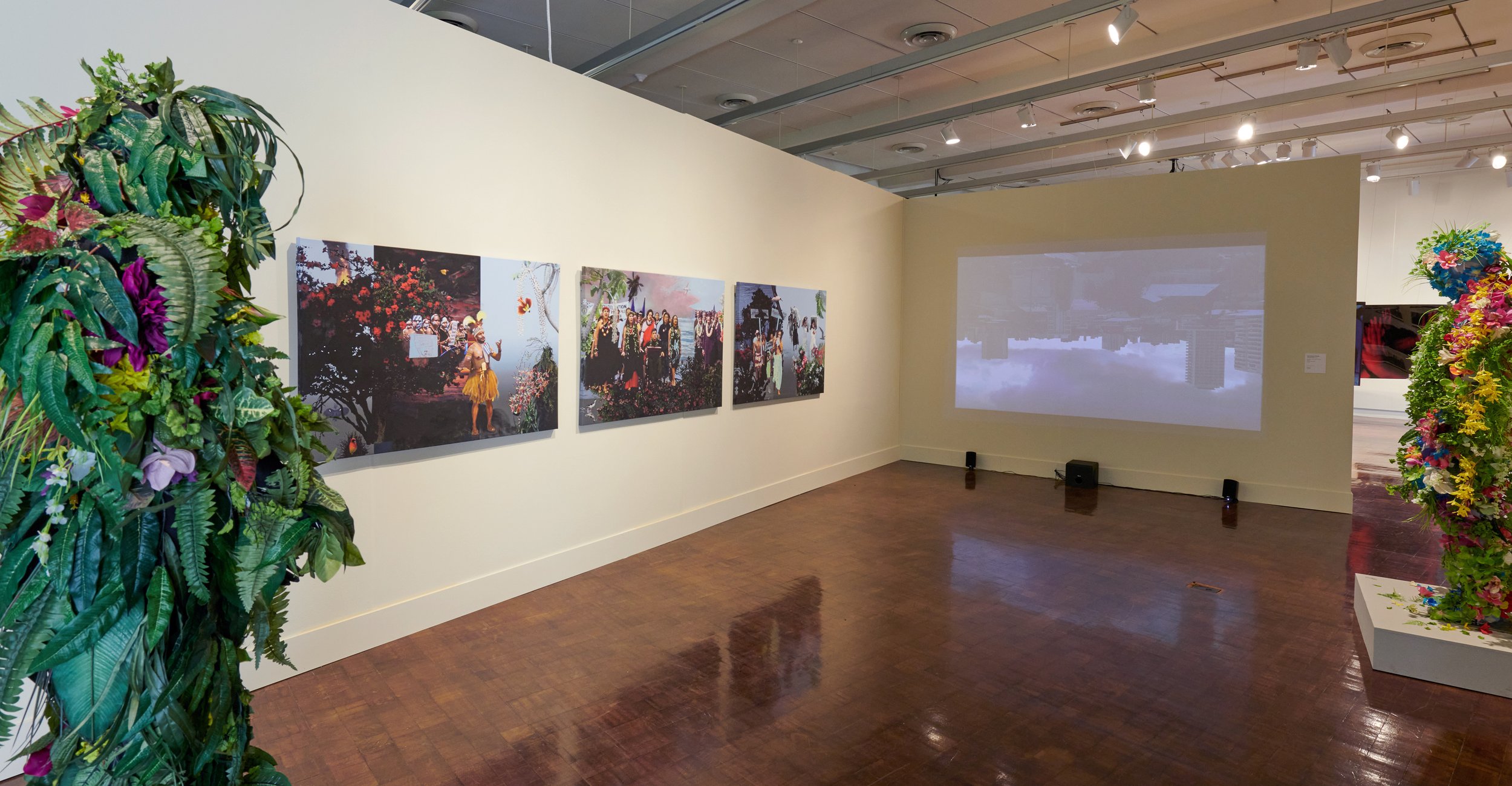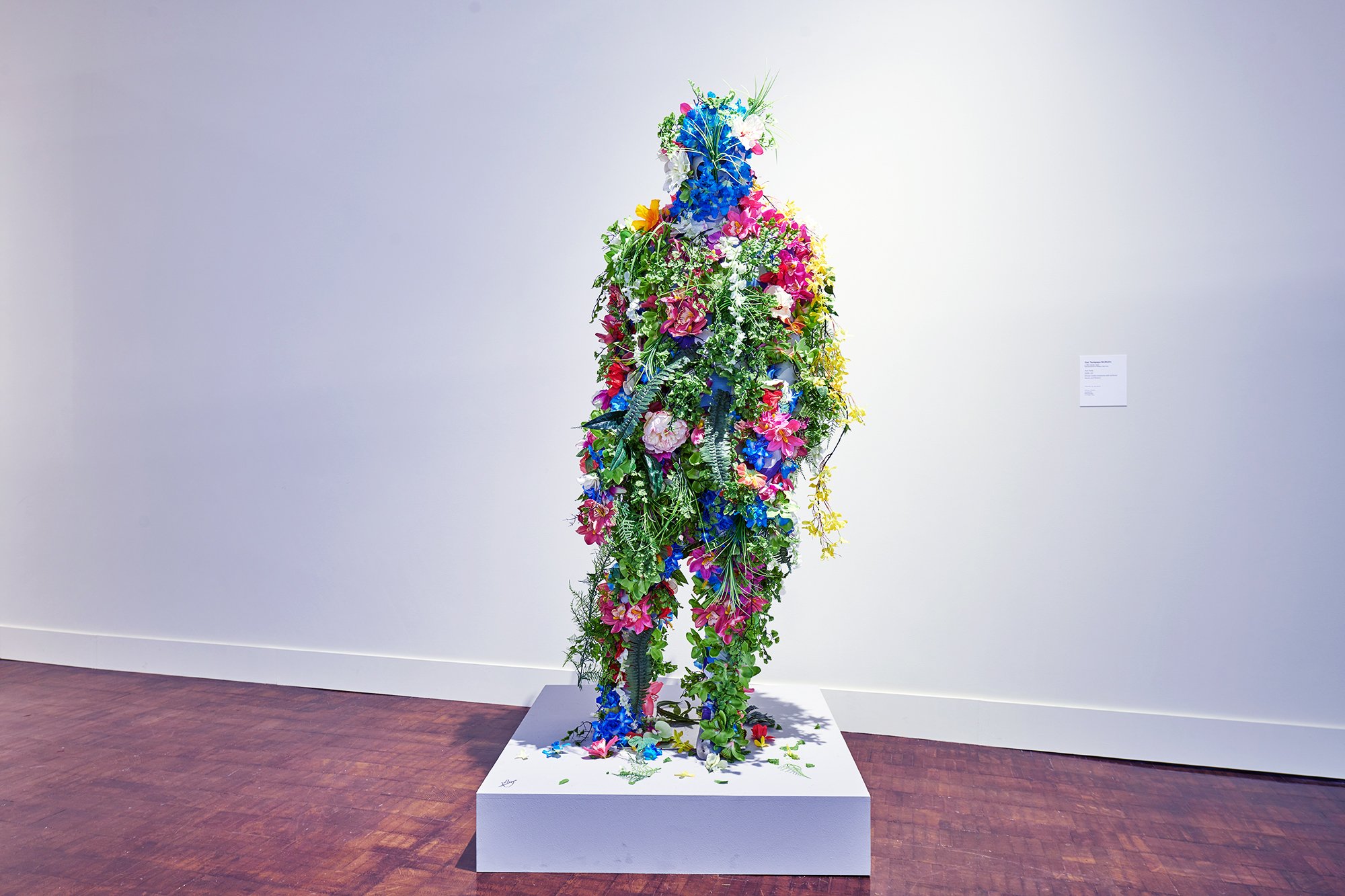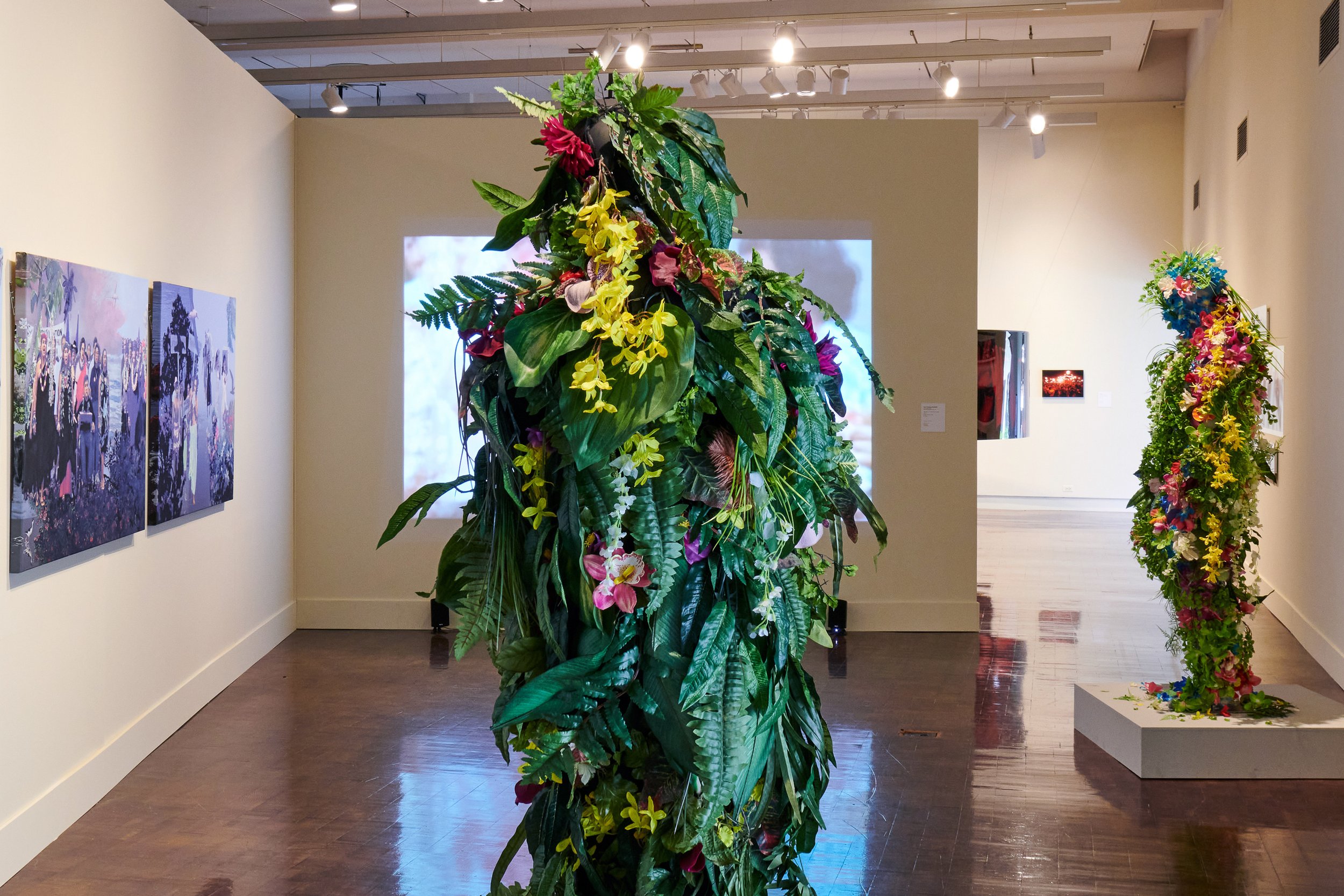hawai‘i triennial 2022
@ HONOLULU MUSEUM OF ART
Dan Taulapapa McMullin
b. 1957, Sendai, Japan
lives and works in Hudson, New York
Installation views: Dan Taulapapa McMullin, Auē Away, 2016–22, mixed-media bodysuits with artificial leaves and flowers; Auē Away / ‘O Sina ma Le ‘Ulafala, 2022, single-channel video, 15 mins; and Seiana, 2022, acrylic and vinyl on digital photo-collage on canvas, Honolulu Museum of Art, HT22, Honolulu. Courtesy of the artist and Hawai‘i Contemporary. Photos: Christopher Rohrer.
Dan Taulapapa McMullin is a Sāmoan faʻafafine artist and writer lifting up queer theirstories, communities, bodies, sexualities, languages, and knowledges of Polynesia. Through written and spoken word, collaborative research, publishing, and performance, as well as painting, sculpture, video, and installation, Taulapapa addresses the violent erasure and careless commodification of Moananui under the colonial rule of the United States, England, France, and Spain.
Where? Where are we?
In the wallpaper, on the mugs?
Taulapapa’s questions from ‘Tiki Manifesto’ (2013)—a personal poetic statement—speak
to the enduring presence of Indigenous people today. In 100 Tikis (2016), their filmic intervention into Hollywood movies and tiki kitsch, audiences are reminded that acts of reappropriation can help to re-establish reciprocity. Lest we forget that before, during, and after the reductive backdrops and novelty items of colonial capitalist systems is Indigenous self-determination, sovereignty, and solidarity.
Carrying on their long-standing practice of reclaiming and queering representations of Indigenous culture, Taulapapa has developed a multi-part installation for HT22 titled Aue Away: The Language of Flowers. Expanding on a 2016 installation and 2017 performance, Aue Away is concerned with the ways in which different stories and struggles are often isolated from one another and conversely conflated without critical inquiry. Commenting on their underlying intentions and what inspired the project, Taulapapa writes:
In Samoan seiana means to decorate the self and the other
At moments of encounter and/or celebration
Sei were the objects of decoration
Flowers, leaves, shells, seeds, teeth, bones, feathers
Now sei is used just for the flower on the ear
This practice of seiana was reciprocal
Oneself decorated the other and the other decorated oneself
With colonialism and tourism this was commodified
The price was fixed by colonial economies
The art of reciprocation was lost, the other decorated the self
The sei became commodities, commodities became sei
While seiana disappeared from the colonial economy
It was reserved for the Indigenous encounter
Within the Indigenous encounter there is constant conflict
Between time and timelessness
In the white space there is seiana
But it is in conflict with itself, it is in the process of creation
They are imaginary but they are from all my loved ones
They are not real but they are my ancestors and our descendants
The seiana is their song, which we cannot hear
Within this scene of encounter, trauma, mourning, celebration, and reciprocation, Taulapapa expresses their desire to decorate and be decorated, to adorn and be adorned. Bind them—the self and the other—together, string them—the self and the other—together, loop them—the self and the other—together. Within the picture plane of a large triptych, Taulapapa brings seemingly disparate flowers, leaders, places, and movements together: Tiare, Martin Luther King Jr, Bikini, Hawaiian sovereignty demonstrations, plumeria, Henri Hiro, Honolulu, West Papuan independence rallies, ʻōhiʻa lehua, Benny Wenda, Papeʻete, civil rights marches, king protea, Haunani-Kay Trask, Selma, Tahitian anti-nuclear protests.
Developed in collaboration with T.J. Keanu Tario, Kaina Quenga, and Anthony Aiu, Taulapapa’s installation for HT22, including painting, video, sculpture, and performance, establishes connections between Indigenous sovereignty across the Pacific and radical Blackness in the continental U.S. Within this intersection of movements and from a queer perspective, they explore the relationships between populist and political representation, between abstraction and figuration. In parallel, their artist book on the queer theirstory of Polynesia will be published by Honolulu-based nonprofit arts organizations Puʻuhonua Society and Tropic Editions in 2022.
Dan Taulapapa McMullin (2019). Photo: Ulf Skogsbergh, Southhampton, New York.
Dan Taulapapa McMullin is an artist and poet from Sāmoa i Sasa'e (Eastern Samoa, American Samoa) who identifies as Fa'afafine. Their book of collected poems Coconut Milk (University of Arizona Press, 2013) was on the American Library Association Rainbow List Top Ten Books of the Year. Samoan Queer Lives (2018), co-edited with Yuki Kihara, is a collection of Fa'afafine interview published by Little Island Press of Aotearoa-New Zealand. Their film Sinalela won the 2002 Honolulu Rainbow Film Festival Best Short Film Award. Taulapapa's art studio and writing practice is based in Hudson, New York, where they live with their partner. They are currently working on a graphic narrative on the queer history of Polynesia.






